43 results
Middle school biology activities for SMART Notebook

Mendelian Genetics Unit: Lesson 7: Your Monster and Punnet Squares
Now that students know how to set up Punnet squares and predict future genotypes and phenotypes, have them do the same with their monsters!
Students will pick a partner in class, and their two monsters will fall in love and have many monster babies! Students will select traits, and will create 10 punnets squares that will show the possible outcomes for four different babies.
Finally, students will put together a packet with their adult monsters (illustrated with their genotypes and phenotypes
Subjects:
Grades:
6th - 8th
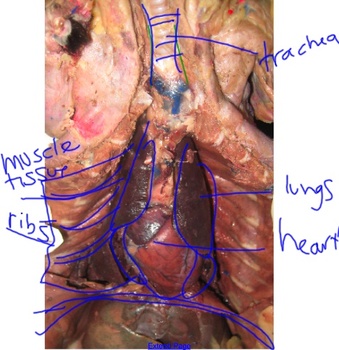
Mink Dissection
This is the presentation I created to help my students through each major step of a mink dissection.
While the presentation came in handy, I also modeled each step for them, but tried not to show them TOO much as I went-- there's something great in the discovery being theirs.
As they started opening each mink, I would call them back, show more pictures on the board, or model through mine a bit more, quizzing as I went.
(The first day is the toughest as students have to find the trachea and e
Subjects:
Grades:
6th - 9th
Types:
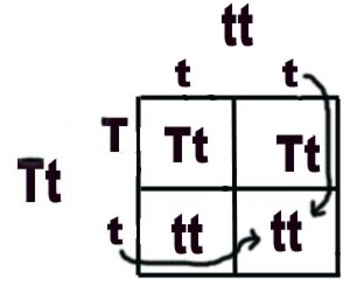
Mendelian Genetics Unit: Lesson 6: Intro to Punnet Squares
Before students can continue their monster project, they need to learn how to organize information about alleles, and predict future offspring using Punnet squares!
This lesson focuses on how to organize information without a Punnet square, and looks at the pros and cons of solving a different way, then shows the more streamlined Punnet squares with side by side comparisons so students can see the exact same information is in both.
There are levels of practice problems ranging from simple (fil
Subjects:
Grades:
6th - 8th

Cell Unit Review Jeopardy Game, Middle School Science, Life science, 6-8 Science
This is a smart notebook format jeopardy game of Cell unit.
It is good for unit review and no prep days:)
In the preview document you'll see only 2 questions.
The Categories in this game;
The Characteristics of Cells
Chemistry of Life
Cell Structure and Function
Levels of Cellular Organization
Cell Processes
Have fun!
Thank you for downloading.
Subjects:
Grades:
5th - 12th

Mendelian Genetics Unit: Lesson 5: Mendelian Monster Project
In the first part of this culminating genetics project, students will randomly design and illustrate their own monsters. On the final illustration, students will label both genotypes and phenotypes of their monster.
In the next two lessons, students will create punnet squares between their monster and a fellow classmate's monster to see what potential offspring would look like.
For six years, students identified this project as one of their favorites of the year.
Key words: genetics, Mende
Subjects:
Grades:
6th - 8th
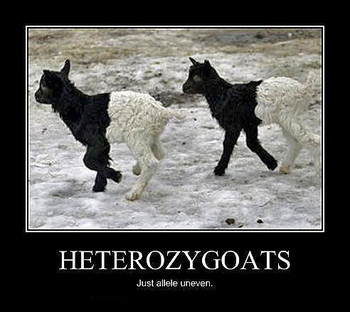
Mendelian Genetics Unit: Lesson 4: Homozygous & Heterozygous
Key terms: gene, allele, phenotype, genotype, dominant, recessive, homozygous, heterozygous, genetics
Building on the previous 3 lessons, students will look for the connection between genotypes and phenotypes, differentiate between homozygous and heterozygous genotypes, complete word studies and graphic organizers, predict possible offspring based on observable traits, use genotypic codes, solve crossword puzzles for vocabulary review and more.
This can be taught in 60-90 minutes. The lesson
Subjects:
Grades:
6th - 8th
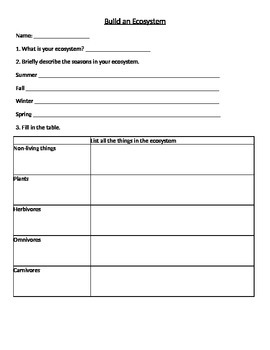
Build an Ecosystem
This mini unit has four lessons: What is an ecosystem, biomes, human interactions and it ends with a planning page for students to build a model of an ecosystem.
Subjects:
Grades:
5th - 7th
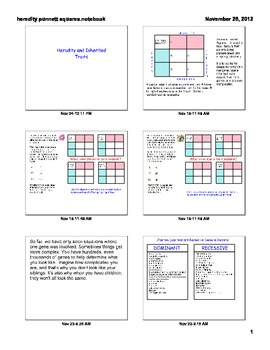
SMARTBOARD lesson on inherited traits and heredity
This smartboard lesson showcases how to track dominant and recessive traits in plants and animals. It also hits on common dominants and recessive traits in humans, so students can search for them in their classmates as a lab exploration.
Grades:
4th - 12th, Adult Education
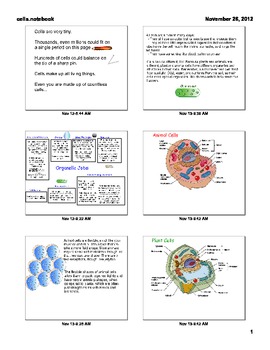
SMARTBOARD lesson on plant and animal cells
This smartboard lesson showcases how the human body is organized from cells to tissues, to organs, to organ systems to bodies. It also discusses the structures within plant and animal cells, comparing them to each other and to the organs of the human body.
Grades:
4th - 12th, Adult Education
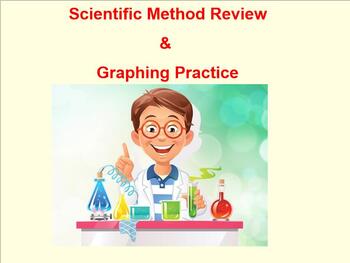
Scientific Method Review & Graphing Practice - Living Environment- (Notebook 11)
This product contains 30 slides reviewing Graphing and the Scientific Method. There is enough work to keep your students busy for three hours! Just open and start teaching. You will find interactive activities, Regents questions (with answers). 5 graphs (with answers), and a study guide with questions and answers. (To show your students the answers, just click on the lines and the answers will fade in.) *This lesson was designed with a lot of visuals and scaffolding techniques in order to help E
Subjects:
Grades:
7th - 12th
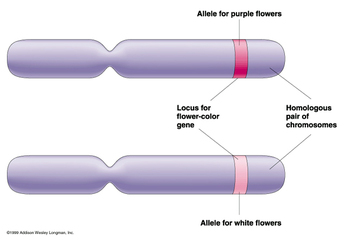
Mendelian Genetics Unit: Lesson 2: Genes vs. Alleles
In this second lesson, students dig deeper into inherited traits to define a gene, the placement of a gene on DNA/a chromosome, and the relationship between a gene and an allele. Teaching time-- 60-90 minutes.
Included: web links, worksheets, graphic organizers, answer keys, guided notes
Key words: gene, allele, genetics, inherited trait, acquired trait, phenotype, chromosome, DNA
There are additional activities for a second day which may also be exchanged with the first, used in centers, use
Subjects:
Grades:
6th - 8th

Dissection Notes and Chicken Wing and Pickle Dissection LABS
My students spend a few days in class learning about bones, ligaments, tendons, skeletal muscles, cartilage, marrow, and tendons. I want the students to observe these parts first hand by dissecting a chicken wing.
The attached document contains notes about dissection tools and techniques. It then has a practice lab where students dissect a pickle. Finally, the document contains the chicken wing dissection lab. Teacher notes are provided for both labs.
Subjects:
Grades:
6th - 9th
Types:

Plants: Lesson 3: Observing Edible Plants
Even though plants are part of our daily lives, often when studying them, we forget to include relevance. In order to connect to plant life, this lesson revolves around the idea of food.
During the hook, we start a multi-day observation of the xylem using celery (to tie into the previous day's lesson). Then, students get to touch, draw, discuss and identify parts of carrots, radishes, celery and more.
Most students were disturbed or surprised to learn they were eating roots, stems or leaves-
Subjects:
Grades:
5th - 8th

Smartboard Life Cycle of a Butterfly
The is a clear step by step explanation of the life cycle of a butterfly.
Subjects:
Grades:
2nd - 6th

Cells Smartboard Sort | Unicellular and Multicellular Organisms
This is a Smartboard vortex sort where students will sort statements into one of two groups: unicellular organisms or multicellular organisms. Student receive instant feedback. If they are correct, the vortex accepts the statement. If they are incorrect, the vortex will bounce the statement out.
Grades:
5th - 7th
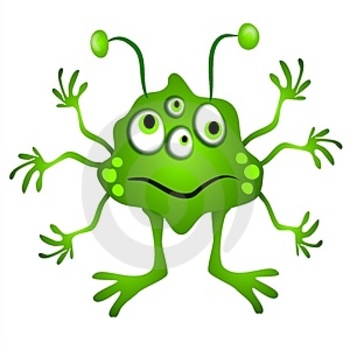
Genetics Alien Challenge
Aliens have landed in your home town! Students noticed right away that said aliens reproduced by clapping hands, and teams of two wrote down observations about the next generations in their science journals.
Objective: Your challenge is to read the students' science journals, reorganize the information, and determine which traits are dominant and which traits are recessive! Be prepared to talk about specific aliens/examples and justify your reasoning!
Key words: dominant, recessive, trait, ho
Subjects:
Grades:
6th - 8th

Scientific Method Smartboard Lesson
Students learn the steps of the scientific method with a hypothetical or real lab of crickets and temperature.
Subjects:
Grades:
5th - 7th

ANATOMY - SMART Notebook - Muscle Anatomy Interactive Review
This interactive SMART Notebook provides an opportunity to identify the major muscle groups of the human anatomy. Students can identify muscles ventral and dorsal and use pull tabs to check their answers.
This work by SMARTERTEACHER is licensed under a Creative Commons Attribution-NonCommercial 3.0 Unported License.
Grades:
7th - 12th

Vascular and Non-Vascular Plants Venn Diagram
This is a Smart Notebook activity comparing and contrasting vacular and non-vascular plants. Students can manipulate characteristics and explain in a whole group or small group setting the differences between a vascular plant and non-vascular plant. This includes common examples of both types of plants.
Subjects:
Grades:
4th - 8th

Life Science Koosh Ball SMART Board Review Game
This SMART Notebook 11 file reviews how scientists classify living organisms, parts of cells, and asks questions about the five kingdoms. Notebook file could be easily edited and used as a template for other units of study. Notebook works with koosh ball.
Subjects:
Grades:
4th - 6th

Life Cycle of a Flowering Plant SmartBoard Lesson! Interactive! Videos too!
Interactive SmartBoard lesson on the Stages of a Flowering Plant's Life Cycle: Germination, Plant Development, Fertilization & Seed Production.
Students will use the fill in the blank notes guide (available in store) to take notes from the lesson. In this lesson, there is an embedded interactive labeling activity from biology.ualberta! (link included, page can be printed for handout too). There is also a link to the Brainpop episode - username and password included!) There are multiple che
Subjects:
Grades:
4th - 7th
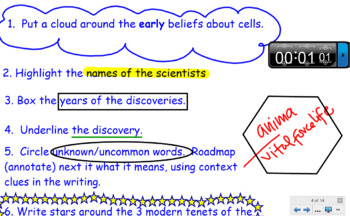
Cell Theory Close Read and Timeline SmartBoard Presentation
This is a presentation to be used to close read about the cell theory. It gives two different options for the close read. My store has a bundle that includes the article, student graphic organizer, questions, etc.
Subjects:
Grades:
7th - 12th

Introduction to Classifying Organisms Smartboard
This is a SMARTboard I used to introduce 6th grade science units on plants and animals. The focus of the the lesson is introducing what an organism is and how organisms are scientifically classified. I taught these lessons over a 2-3 day period.
I designed the interactive SMARTboard presentation to be used with a science notebook, where the students complete each page in their notebook. If science notebooks are not available, handouts could be generated from the presentation pages.
The pres
Subjects:
Grades:
5th - 8th

Meiosis Interactive SmartBoard Presentation/Notes
This is an interactive notes presentation for students to record notes on meiosis.
Subjects:
Grades:
7th - 10th
Showing 1-24 of 43 results





